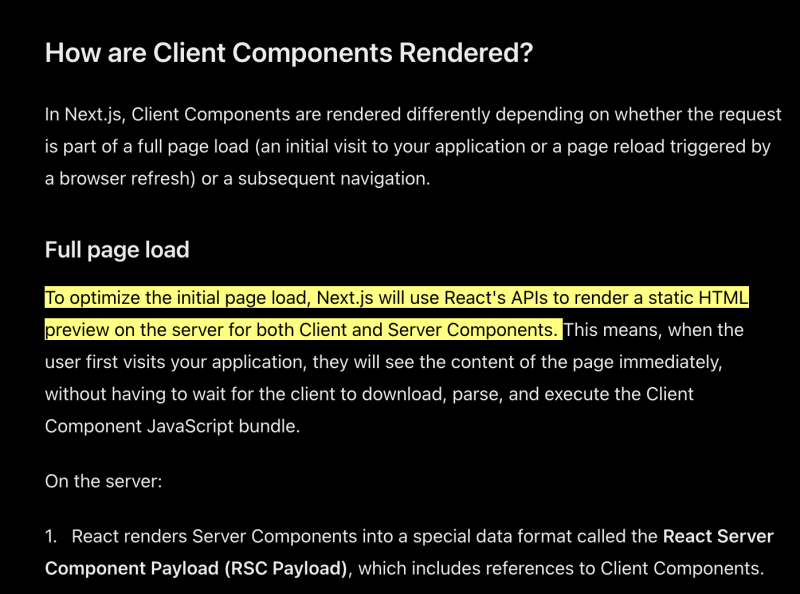1 - How to use 'use client'
There are two ways to make a component client-side.
No.1: Add 'use client' at the beginning of the file
By adding 'use client' at the beginning of the file, it becomes a Client Component. I think this is the most basic configuration method.
// app/ClientComponent.tsx 'use client' export default function ClientComponent(){ return ( <button onClick={()=>{ console.log('Hello, Client') }}>BUTTON</button> ) } // app/page.tsx import ClientComponent from './ClientComponent.tsx' export default function Page(){ return( <div> <ClientComponent /> </div> ) } No.2: Pass through the file with 'use client'
Even if the component file itself does not have 'use client', you can make it a Client Component by importing it into another file with 'use client'.
// app/ClientComponent.tsx export default function ClientComponent(){ return ( <button onClick={()=>{ console.log('Hello, Client') }}>BUTTON</button> ) } // app/client.ts 'use client' export { default } from './ClientComponent.tsx' // app/page.tsx import ClientComponent from './client.ts' export default function Page(){ return( <div> <ClientComponent /> </div> ) } Thanks to this specification, even if an external library component does not support Client Component, you can treat it as a Client Component by adding 'use client' to an arbitrary file and importing/exporting it.
However, please note that I explain more in the following section.
2 - Do not directly nest Server Components
If you import Server Component directly into the file of a Client Component and nest it, the Server Component will be treated as a Client Component (due to the specification shown in No.2 earlier).
To prevent this, set {children} on the Client Component side and wrap it with the opening tag of the Client Component.
// ❌ // app/ServerComponent.tsx export default function ServerComponent(){ return( <div>Hello, Server</div> ) } // app/ClientComponent.tsx 'use client' import ServerComponent from './ServerComponent.tsx' export default function ClientComponent(){ return ( <button onClick={()=>{console.log("Hello, Client")}}> <ServerComponent /> </button> ) } // app/page.tsx import ClientComponent from './ClientComponent.tsx' export default function Page(){ return( <div> <ClientComponent /> </div> ) } // ⭕️ // app/ServerComponent.tsx export default function ServerComponent(){ return( <div>Hello, Server</div> ) } // app/ClientComponent.tsx 'use client' export default function ClientComponent(){ return ( <button onClick={()=>{console.log("Hello, Client")}}> { children } </button> ) } // app/page.tsx import ClientComponent from './ClientComponent.tsx' import ServerComponent from './ServerComponent.tsx' export default function Page(){ return( <div> <ClientComponent> <ServerComponent /> </ClientComponent> </div> ) } It is not necessary to always wrap it with the opening tag. However, you don't want to bring what can be generated on the server side to the client side, right?
3 - Do not import modules from index files (cannot)
CAUTION
This section was incorrect.
You cannot import from an index.ts/js file into a Client Component.
// CAN NOT DO THIS // lib/index.ts export const sayHello = () => {console.log('Hello') // app/ClientComponent.tsx 'use client' import { sayHello } from '../lib' export default function ClientComponent(){ return ( <button onClick={()=>{ sayHello() }}> You can't do this with ERROR </button> ) } If you try to do this, you will get the following error.
4 - Pre-Rendering
Client components are first rendered on the server side.
The official documentation mentions the following.
For example, let's say you accidentally use a function inside the component that relies on the document object.
// getDataTheme.ts export const getDataTheme = () => document.documentElement.getAttribute('data-theme') // Button.tsx 'use client' import {getDataTheme} from './getDataTheme' export default function Button(){ return ( <div>{getDataTheme()==='dark'?'Moon':'Sun'}</div> ) } In this case, you will likely see the following warning:
ReferenceError: document is not defined
This is likely caused by using a client-side API on the server side. Find a way to avoid this issue.
I have summarized the knowledge when creating Client Components. I hope it will be helpful to you.
That's all.




Top comments (0)